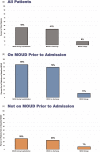Undertreatment of opioid use disorder in patients hospitalized with injection drug use-associated infections
- PMID: 37352497
- PMCID: PMC10481931
- DOI: 10.1097/QAD.0000000000003629
Undertreatment of opioid use disorder in patients hospitalized with injection drug use-associated infections
Abstract
Objective: To evaluate the association between medication for opioid use disorder (MOUD) initiation and addiction consultation and outcomes for patients hospitalized with infectious complications of injecting opioids.
Method: This was a retrospective cohort study performed at four academic medical centers in the United States. The participants were patients who had been hospitalized with infectious complications of injecting opioids in 2018. Three hundred and twenty-two patients were included and their individual patient records were manually reviewed to identify inpatient receipt of medication for opioid use disorder (MOUD), initiation of MOUD, and addiction consultation. The main outcomes of interest were premature discharge, MOUD on discharge, linkage to outpatient MOUD, one-year readmission and death.
Results: Three hundred and twenty-two patients were predominately male (59%), white (66%), and median age 38 years, with 36% unstably housed, and 30% uninsured. One hundred and forty-five (45%) patients received MOUD during hospitalization, including only 65 (28%) patients not on baseline MOUD. Discharge was premature for 64 (20%) patients. In the year following discharge, 27 (9%) patients were linked to MOUD, and 159 (50%) patients had at least one readmission. Being on MOUD during hospitalization was significantly associated with higher odds of planned discharge [odds ratio (OR) 3.87, P < 0.0001], MOUD on discharge (OR 129.7, P < 0.0001), and linkage to outpatient MOUD (OR 1.25, P < 0.0001), however, was not associated with readmission. Study limitations were the retrospective nature of the study, so post-discharge data are likely underestimated.
Conclusion: There was dramatic undertreatment with MOUD from inpatient admission to outpatient linkage, and high rates of premature discharge and readmission. Engagement in addiction care during hospitalization is a critical first step in improving the care continuum for individuals with opioid use disorder; however, additional interventions may be needed to impact long-term outcomes like readmission.
Conflict of interest statement
E.S.R. reports investigator-initiated grants paid to the institution from Gilead and Merck. S.K reports investigator-initiated grants paid to the institution from Gilead. S.K advises for and received grants from Merck and received grants from Gilead and Arbutus. G.A.B reports research funding paid to the institution from Merck Foundation and Eli Lilly and honoraria from Med-IQ.
Figures



Similar articles
-
Addiction Consult Service and Inpatient Outcomes Among Patients with OUD.J Gen Intern Med. 2024 Nov;39(15):2961-2969. doi: 10.1007/s11606-024-08837-0. Epub 2024 Aug 13. J Gen Intern Med. 2024. PMID: 39136887 Free PMC article.
-
Inpatient Opioid Use Disorder Treatment by Generalists is Associated With Linkage to Opioid Treatment Programs After Discharge.J Addict Med. 2022 Mar-Apr 01;16(2):169-176. doi: 10.1097/ADM.0000000000000851. J Addict Med. 2022. PMID: 33813579 Free PMC article.
-
Associations Between Inpatient Induction on Medications for Opioid Use Disorder and Postdischarge Medications for Opioid Use Disorder Adherence, Overdose, and Service Use.J Addict Med. 2023 May-Jun 01;17(3):e199-e201. doi: 10.1097/ADM.0000000000001092. Epub 2022 Oct 16. J Addict Med. 2023. PMID: 37267183
-
The Substance Use Treatment and Recovery Team (START) study: protocol for a multi-site randomized controlled trial evaluating an intervention to improve initiation of medication and linkage to post-discharge care for hospitalized patients with opioid use disorder.Addict Sci Clin Pract. 2022 Jul 28;17(1):39. doi: 10.1186/s13722-022-00320-7. Addict Sci Clin Pract. 2022. PMID: 35902888 Free PMC article.
-
Management of opioid withdrawal and initiation of medications for opioid use disorder in the hospital setting.Hosp Pract (1995). 2022 Oct;50(4):251-258. doi: 10.1080/21548331.2022.2102776. Epub 2022 Jul 22. Hosp Pract (1995). 2022. PMID: 35837678 Review.
Cited by
-
Real-World Dalbavancin Use for Serious Gram-Positive Infections: Comparing Outcomes Between People Who Use and Do Not Use Drugs.Open Forum Infect Dis. 2024 Apr 5;11(4):ofae186. doi: 10.1093/ofid/ofae186. eCollection 2024 Apr. Open Forum Infect Dis. 2024. PMID: 38651139 Free PMC article.
-
Developing a remotely delivered intensive outpatient program adapted for hospitalized patients with opioid use disorder: A qualitative study.Addict Behav Rep. 2024 Apr 19;19:100546. doi: 10.1016/j.abrep.2024.100546. eCollection 2024 Jun. Addict Behav Rep. 2024. PMID: 38680207 Free PMC article.
-
Association between housing status and mental health and substance use severity among individuals with opioid use disorder and co-occurring depression and/or PTSD.BMC Prim Care. 2025 Aug 8;26(1):250. doi: 10.1186/s12875-025-02947-2. BMC Prim Care. 2025. PMID: 40781589 Free PMC article.
-
Hospitalization is a missed opportunity for HIV screening, pre-exposure prophylaxis, and treatment.Addict Sci Clin Pract. 2024 Mar 26;19(1):22. doi: 10.1186/s13722-024-00451-z. Addict Sci Clin Pract. 2024. PMID: 38528590 Free PMC article.
-
Hospital admissions among patients with Comorbid Substance Use disorders: a secondary analysis of predictors from the NavSTAR Trial.Addict Sci Clin Pract. 2024 Apr 28;19(1):33. doi: 10.1186/s13722-024-00463-9. Addict Sci Clin Pract. 2024. PMID: 38678216 Free PMC article. Clinical Trial.
References
-
- Ahmad FBRL, Sutton P. Provisional drug overdose death counts. National Center for Health Statistics. 2021.
Publication types
MeSH terms
Substances
Grants and funding
LinkOut - more resources
Full Text Sources
Medical

